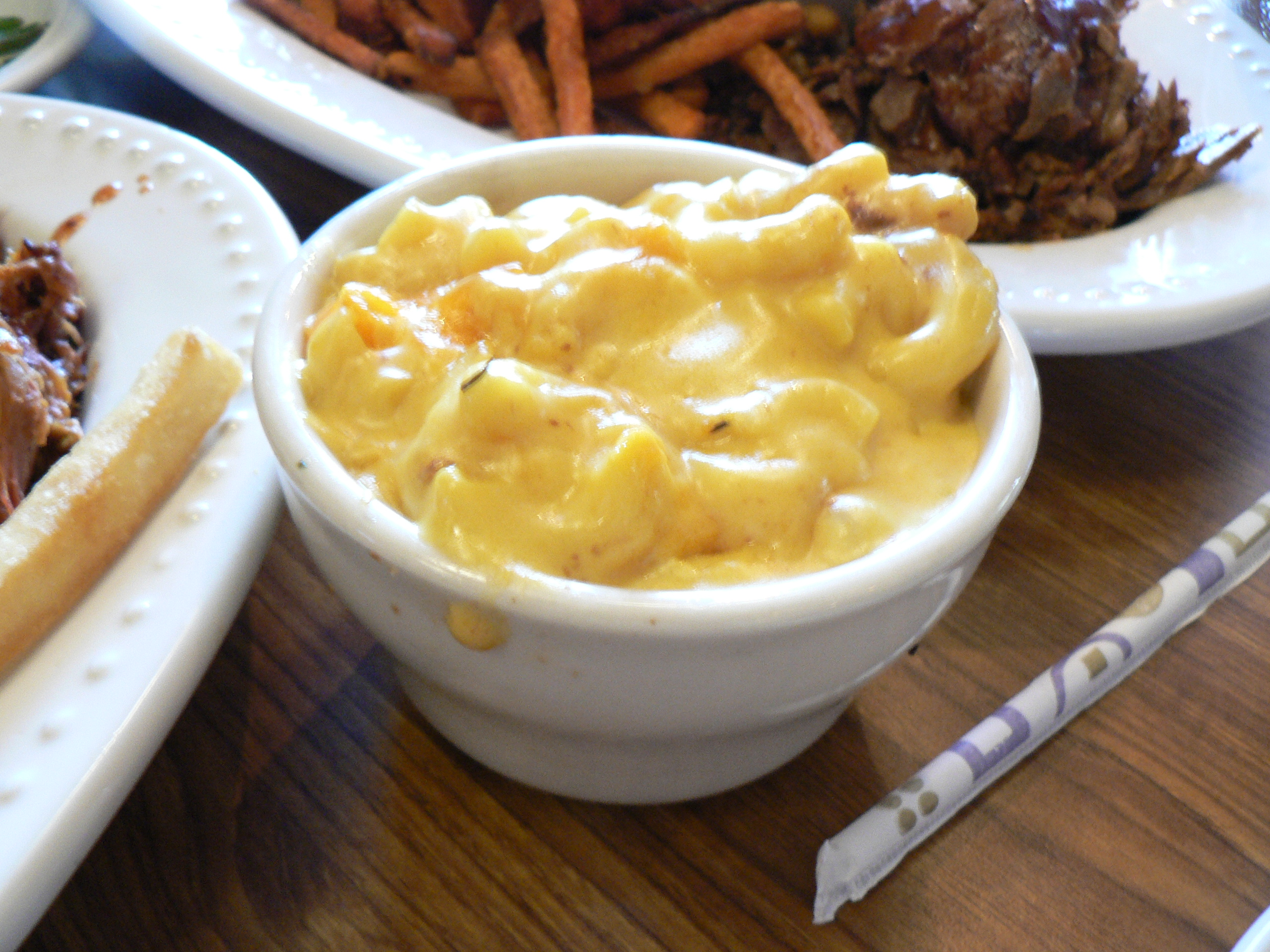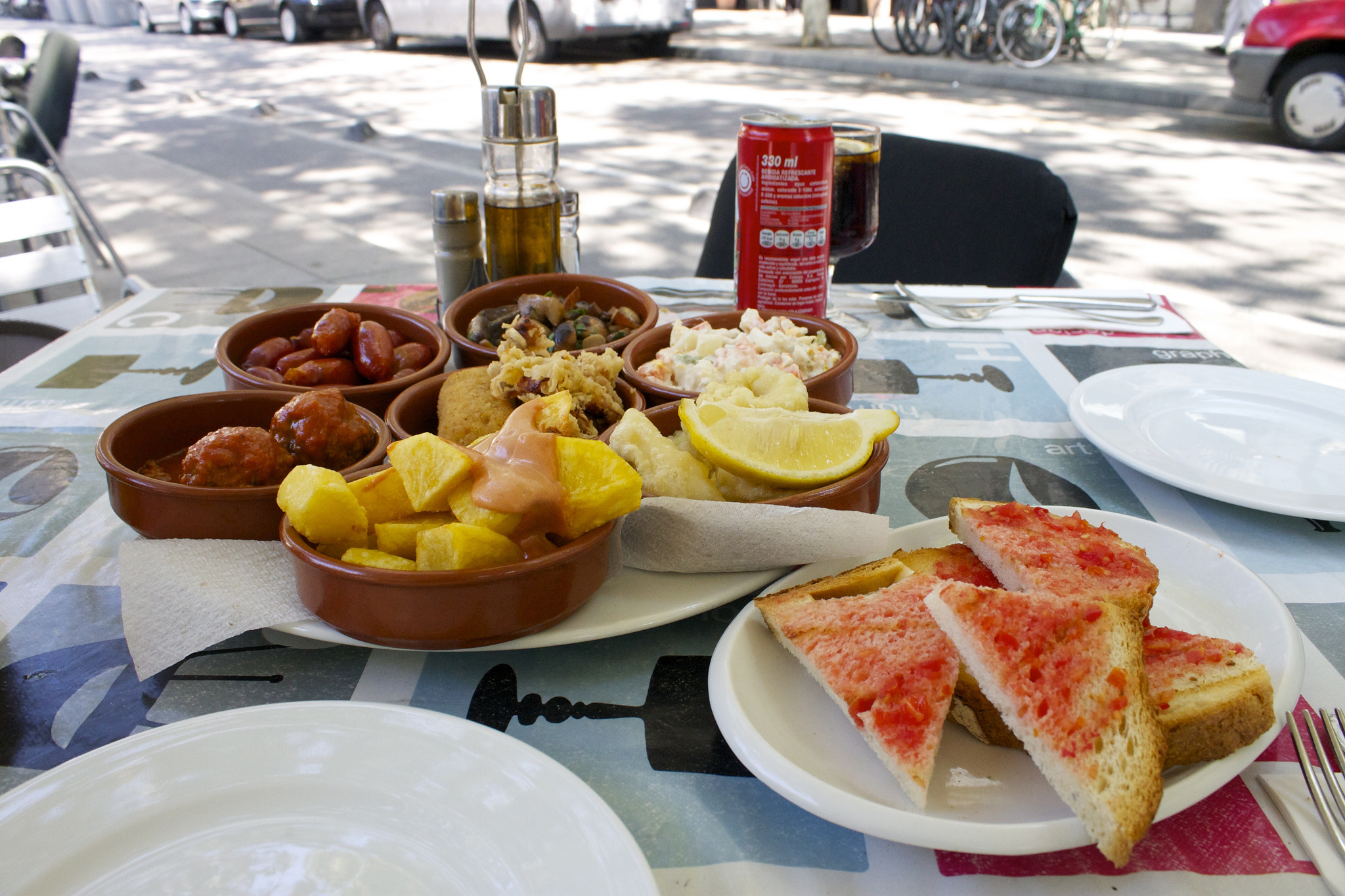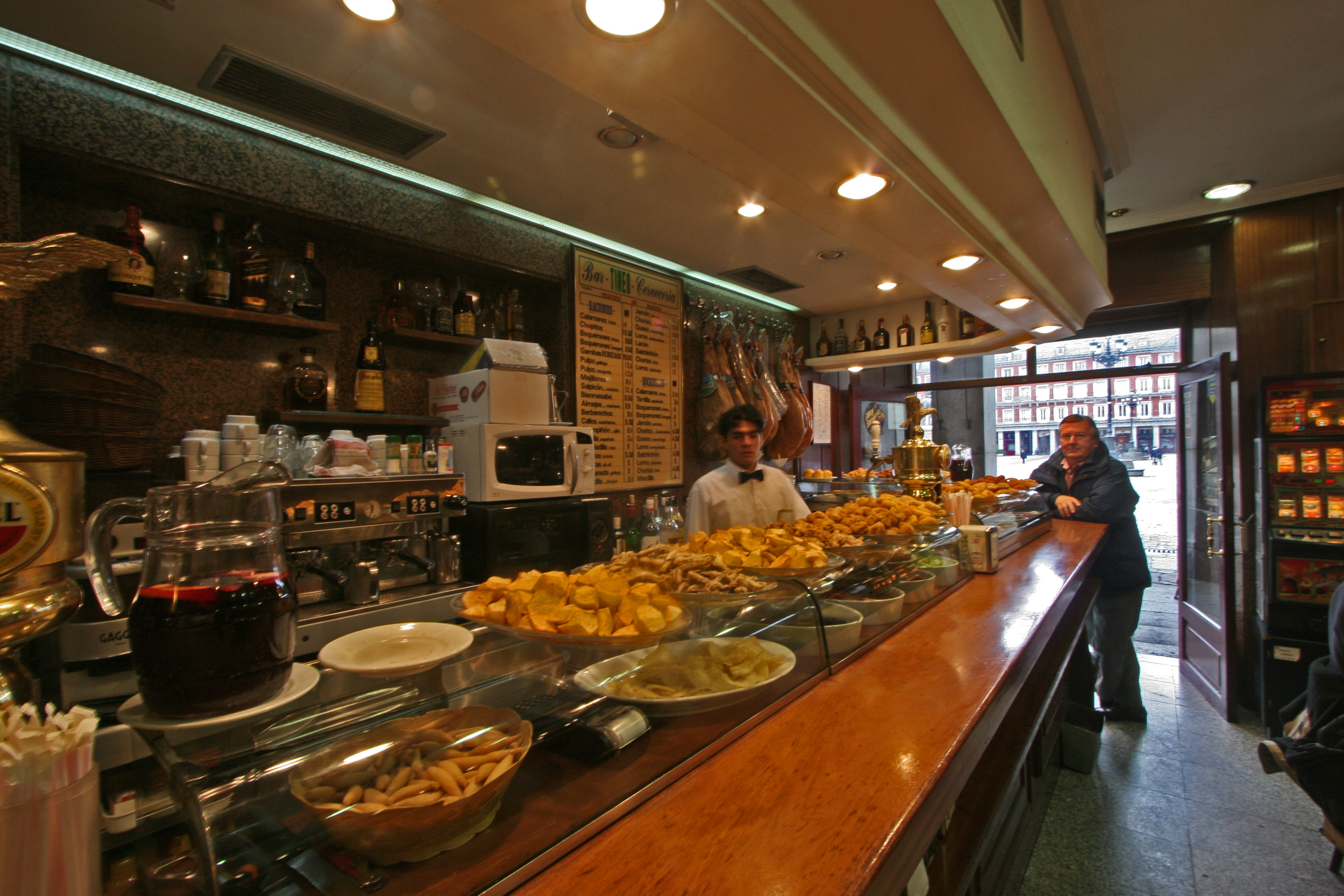|
Small Plates
Small plates is a manner of dining that became popular in US food service after 2000. ''Small plates'' may either refer to small dishes resembling appetizers which are ordered à la carte and often shared, such as tapas, or to the small Course (dining), courses served as part of a more formal meal. Types Some types of small plates which have influenced the modern US concept are: * Tapas, a wide variety of appetizers in Spanish cuisine * Mezze, a wide variety of appetizers in Turkish cuisine, and sometimes in Greek cuisine * Antipasti and Cicchetti (food), cicchetti in Italian cuisine * Banchan, in Korean cuisine * Sozai ( ja, :ja:惣菜, 惣菜), the small and usually shared dishes served at an izakaya, a Japanese cuisine, Japanese pub * The pu pu platter of Cuisine of Hawaii, Hawaiian cuisine * Zakuski in Russian cuisine * Side dish ( zh, :zh:小菜, 小菜, which literally translates to "small dish") in Chinese cuisine References * Appetizers Serving and dining {{fo ... [...More Info...] [...Related Items...] OR: [Wikipedia] [Google] [Baidu] |
Tapas En El Raval
A tapa () is an appetizer or snack in Spanish cuisine. Tapas can be combined to make a full meal, and can be cold (such as mixed olives and cheese) or hot (such as ''chopitos'', which are Batter (cooking), battered, frying, fried baby Squid (food), squid, or patatas bravas). In some bars and restaurants in Spain and across the globe, tapas have evolved into a very sophisticated cuisine. In some Central American countries, such snacks are known as ''bocas''. In parts of Mexico, similar dishes are called ''botanas''. History The word "tapas" is derived from the Spanish verb ''tapar'', "to cover", a cognate of the English ''top''. In pre-19th-century Spain tapas were served by Inn, ''posadas'', Hostal, ''albergues'' or Wine bar, ''bodegas'', offering meals and rooms for travellers. Since few innkeepers could write and few travellers read, inns offered their guests a sample of the dishes available, on a "tapa" (the word for pot cover in Spanish). According to ''Joy of Cooking' ... [...More Info...] [...Related Items...] OR: [Wikipedia] [Google] [Baidu] |
Banchan
''Banchan'' (, from Korean: ) or bansang are small side dishes served along with cooked rice in Korean cuisine. As the Korean language does not distinguish between singular and plural grammatically, the word is used for both one such dish or all of them combined. The basic table setting for a meal called ''bansang'' (반상) usually consists of ''bap'' (밥, cooked rice), ''guk'' or ''tang'' (soup), ''gochujang'' or ''ganjang'', ''jjigae'', and ''kimchi''. According to the number of ''banchan'' added, the table setting is called ''3 cheop'' (삼첩), ''5 cheop'' (오첩), ''7 cheop'' (칠첩), ''9 cheop'' (구첩), ''12 cheop'' (십이첩) ''bansang'', with the ''12 cheop'' used in Korean royal cuisine. ''Banchan'' are set in the middle of the table to be shared. At the center of the table is the secondary main course, such as ''galbi'' or ''bulgogi'', and a shared pot of ''jjigae''. Bowls of cooked rice and ''guk'' (soup) are set individually. ''Banchan'' are served in sma ... [...More Info...] [...Related Items...] OR: [Wikipedia] [Google] [Baidu] |
Chinese Cuisine
Chinese cuisine encompasses the numerous cuisines originating from China, as well as overseas cuisines created by the Chinese diaspora. Because of the Chinese diaspora and historical power of the country, Chinese cuisine has influenced many other cuisines in Asia and beyond, with modifications made to cater to local palates. Chinese food staples such as rice, soy sauce, noodles, tea, chili oil, and tofu, and utensils such as chopsticks and the wok, can now be found worldwide. The preferences for seasoning and cooking techniques of Chinese provinces depend on differences in historical background and ethnic groups. Geographic features including mountains, rivers, forests, and deserts also have a strong effect on the local available ingredients, considering that the climate of China varies from tropical in the south to subarctic in the northeast. Imperial royal and noble preference also plays a role in the change of Chinese cuisine. Because of imperial expansion and trading, i ... [...More Info...] [...Related Items...] OR: [Wikipedia] [Google] [Baidu] |
Side Dish
A side dish, sometimes referred to as a side order, side item, or simply a side, is a food item that accompanies the entrée or main course at a meal. (definition. Merriam-webster.com Accessed August 2011. Common types 
 Side dishes ...
Side dishes ...
[...More Info...] [...Related Items...] OR: [Wikipedia] [Google] [Baidu] |
Russian Cuisine
Russian cuisine is a collection of the different dishes and cooking traditions of the Russian people as well as a list of culinary products popular in Russia, with most names being known since pre-Soviet times, coming from all kinds of social circles. History The history of Russian cuisine was divided in four groups: Old Russian cuisine (ninth to sixteenth century), Old Moscow cuisine (seventeenth century), the cuisine that existed during the ruling of Peter and Catherine the Great (eighteenth century), and finally Petersburg cuisine, which took place from the end of the eighteenth century to the 1860s. In the Old Russian period, the main food groups were bread, lots of grains, and lots of foods that contained starch. Women baked pies with lots of different fillings, such as mushrooms or berries. During gatherings, a loaf of bread and salt was always present. Kasha, such as buckwheat, oats, etc.were represented as wellbeing to the household. Lots of Russians used honey and ... [...More Info...] [...Related Items...] OR: [Wikipedia] [Google] [Baidu] |
Zakuski
Zakuski (plural from Russian: закуски ; singular zakuska from закуска; Polish: zakąski, zakąska) is an assortment of cold hors d'oeuvres, entrées and snacks in food culture of Russia and in Slavic-speaking countries. It is served as a course on its own or "intended to follow each shot of vodka or another alcoholic drink." The word literally means ''something to bite after''. It probably originated and was influenced through the fusion of Slavic, Viking-Nordic and Oriental cultures in early Rus' regions like the Novgorod Republic. The tradition of zakuski is linked to the Swedish and Finnish ''brännvinsbord'' which was also the ancestor of modern smörgåsbord and to meze of the Ottoman Empire and other Middle Eastern cultures. Zakuski are not served as in Scandinavia at the buffet but on the dining table. Zakuski are also a food-in-itself and often not just served as starter to a meal. Zakuski were kept in the houses of the Russian gentry for feeding casual ... [...More Info...] [...Related Items...] OR: [Wikipedia] [Google] [Baidu] |
Cuisine Of Hawaii
The cuisine of Hawaii incorporates five distinct styles of food, reflecting the diverse food history of settlement and immigration in the Hawaiian Islands. In the pre-contact period of Ancient Hawaii (300 AD-1778), Polynesian voyagers brought plants and animals to the Islands. As Native Hawaiians settled the area, they fished, raised taro for '' poi'', planted coconuts, sugarcane, sweet potatoes and yams, and cooked meat and fish in earth ovens. After first contact in 1778, European and American cuisine arrived along with missionaries and whalers, who introduced their own foods and built large sugarcane plantations. Christian missionaries brought New England cuisine while whalers introduced salted fish which eventually transformed into the side dish lomilomi salmon. As pineapple and sugarcane plantations grew, so did demand for labor, bringing many immigrant groups to the Islands between 1850 and 1930. Immigrant workers brought cuisines from China, Korea, Japan, the Phil ... [...More Info...] [...Related Items...] OR: [Wikipedia] [Google] [Baidu] |
Pu Pu Platter
A pu pu platter is a tray of American Chinese or Hawaiian food consisting of an assortment of small meat and seafood appetizers. The ''Thrillist'' called the pu-pu platter "an amalgam of Americanized Chinese food, Hawaiian tradition and bar food." The pupu platter was probably first introduced to restaurants on the United States mainland by Donn Beach in 1934. It has since become a standard at most Polynesian-themed restaurants such as Don's and Trader Vic's. The earliest known print reference to a pupu platter served at a Chinese restaurant is from 1969. Later, other types of restaurants used "pu pu platter" to describe an appetizer combination platter.In the 1970s, Boston-area Italian restaurants were marketing their appetizers combinations as "Italian pu pu platters". However, pu pu platters are currently more closely associated with American Chinese restaurants. A typical pu pu platter, as found in American Chinese cuisine, includes appetizers such as egg rolls, spare ... [...More Info...] [...Related Items...] OR: [Wikipedia] [Google] [Baidu] |
Japanese Cuisine
Japanese cuisine encompasses the regional and traditional foods of Japan, which have developed through centuries of political, economic, and social changes. The traditional cuisine of Japan (Japanese: ) is based on rice with miso soup and other dishes; there is an emphasis on seasonal ingredients. Side dishes often consist of fish, pickled vegetables, and vegetables cooked in broth. Seafood is common, often grilled, but also served raw as sashimi or in sushi. Seafood and vegetables are also deep-fried in a light batter, as '. Apart from rice, a staple includes noodles, such as soba and udon. Japan also has many simmered dishes, such as fish products in broth called , or beef in and . Historically influenced by Chinese cuisine, Japanese cuisine has also opened up to influence from Western cuisines in the modern era. Dishes inspired by foreign food—in particular Chinese food—like ramen and , as well as foods like spaghetti, curry and hamburgers, have been adapted to Japanes ... [...More Info...] [...Related Items...] OR: [Wikipedia] [Google] [Baidu] |
Izakaya
An () is a type of informal Japanese bar that serves alcoholic drinks and snacks. are casual places for after-work drinking, similar to a pub, a Spanish tapas bar, or an American saloon or tavern. Etymology The word entered the English language by 1987. It is a compound word consisting of ("to stay") and ("sake shop"), indicating that originated from sake shops that allowed customers to sit on the premises to drink. are sometimes called ('red lantern') in daily conversation, as such paper lanterns are traditionally found in front of them. History Anecdotes and songs that appear in the show that -style establishments existed in Japan at the early 700s. There is a record dating to 733 when rice was collected as a brewing fee tax under the jurisdiction of the government office called . In the , written in 797, there is a record of King Ashihara who got drunk and was murdered in a tavern in 761. The full-scale development of began around the Edo period (1603-1867) ... [...More Info...] [...Related Items...] OR: [Wikipedia] [Google] [Baidu] |





